Detroit's Old Tiger Stadium and Honoring History
Today we leave the Northwest and do some baseball tourism!
Somehow it’s the middle of August already? Summer has been flying by over here! I had a vision of churning out newsletters for things I had (mostly) completed research for, and somehow between the kids fighting nonstop, everyday life, the kids asking for snacks incessantly, the Olympics, the kids fighting while they ask for snacks, the end of summer is already in sight? I hope to get back to a more regular newsletter schedule once the kids are back in school. For now, I have some pictures and musings from some baseball tourism I did last year. But first, a couple orders of business!
I’m excited to say I’ll be presenting at the SABR Women in Baseball Conference next month, talking about the women of the Portland Mavericks. This November is the 50th anniversary of the Mavericks hiring Lanny Moss as their general manager, making her the first woman to hold the position in organized baseball. The Mavericks’ off-the-field story is just as compelling and fun as their on-the-field story.
I’ve been doing this newsletter for just over a year now. The researching and the writing is something I love doing and find a lot of joy in. It’s been really gratifying that so many of you have subscribed and read these little stories I dig up. So, thank you all so much! I have more story ideas than I know what to do with and a long, long list of things I want to research more and I appreciate having an audience for them.
The Mariners just finished up a series in Detroit that, out of respect for the baseball portion of our mental health, we can just go ahead and forget. Despite the rough visit, I can’t help but feel affection for the Motor City. A year ago in May, I went there for the first time and naturally found myself on the corner of Michigan and Trumbull.
I was there for my cousin’s wedding. He and his wife live elsewhere, but they wanted to get married at a beautiful Armenian church in the Detroit suburbs that his wife’s grandfather had helped build.
I hadn’t planned to do any touristy things while in town. I was there to hang out with my family and enjoy a few days away from home (through the confluence of pandemic life and small kids, this was the first time I’d gone anywhere by myself in years!). But I had several hours between checking out of the hotel and needing to be at the airport to fly home and I thought I’d like to stand on that famous corner.
I imagined they’d have some sort of plaque to commemorate the site of the former Tiger Stadium, like the one at whichever hardware store now stands at the site of the former Sicks Stadium. I did some internet searching though and found something much better.
*****
I’ve always found Detroit compelling. It used to be Ford and General Motors and Motown music, essential Americana. Then, it was replaced by images of urban rot and decay, of moss growing inside office buildings. White flight. The nightmare when the American Dream goes bad. It could be made into a cautionary tale for so many things, an overwrought knee-jerk symbolism. I admit I was curious to see it for myself; I live in Tacoma after all, a city that, like Detroit, draws a reaction from people who have no idea.
*****
My brother wanted to go with me, and my mom tagged along even though seeing the sites of old baseball stadiums aren’t on her list of fun ways to spend a Sunday afternoon.
I had always wanted to go to Tiger Stadium. I loved when the Mariners played in Detroit and got to watch a game, albeit on tv, in that stadium. The blue, the double decked outfield, there was no other ballpark like it. It looked old and traditional and like it was made for baseball. I was sad when the Tigers moved into their new stadium because I’d never get to watch a baseball game there, and devastated when it was torn down because I’d never get to even see it.
I thought of Tiger Stadium whenever Detroit was mentioned. As someone with no connections to the city, I have no real sense of what it meant there, aside from the way every baseball stadiums. In a clip from the HBO show Hung, which was filmed on the field after the stadium was torn down, a character says that tearing down the stadium “tore out the city’s heart.”
In the clip, they are on the field that remained when the stadium was gone. Weeds sprouted and garbage found its way onto the surface where a century of Detroit baseball was rooted.
After the funeral for the longtime Tiger broadcaster Ernie Harwell in May 2010, a group of fans went to the field to play catch. They wanted to honor him by going to the place where he’d guided them into falling in love with baseball. They were upset by the state of it and decided to care for it themselves. The group grew each weekend as more and more fans joined in to preserve the field they’d loved so much. They called themselves the Navin Field Grounds Crew. Navin Field being the first name for the ballpark, which opened on April 20, 1912, the same day as Fenway Park in Boston.
Though the city objected, the Navin Field Grounds Crew kept showing up. They got the field in shape and staged pickup games and vintage games. Their efforts were showcased in a documentary called Stealing Home in 2014.
In 2016, the Detroit Police Athletic League took over the Tiger Stadium site and began developing it. Detroit PAL is an organization supported by the Detroit Police Department and volunteers to provide athletic programs for kids in Detroit. A small stadium called The Corner Ballpark was built around the field as new condo buildings went up beyond the outfield. Controversially, the grass and dirt field was replaced with field turf, but the footprint of the field at Tiger Stadium is preserved.
We showed up that Sunday afternoon, and I expected to take a few pictures through the gates and that would be that. But as we were walking around, a random door was open. My brother and I looked at each other, shrugged, and walked right in. I wouldn’t have done that alone; I’m too afraid of getting into trouble. But my brother has no such concerns and he can be charming when he needs to be, so I figured he’d get us out of trouble.
Somehow, we didn’t run into anybody. We walked toward the field, where a softball team was finishing up practice.
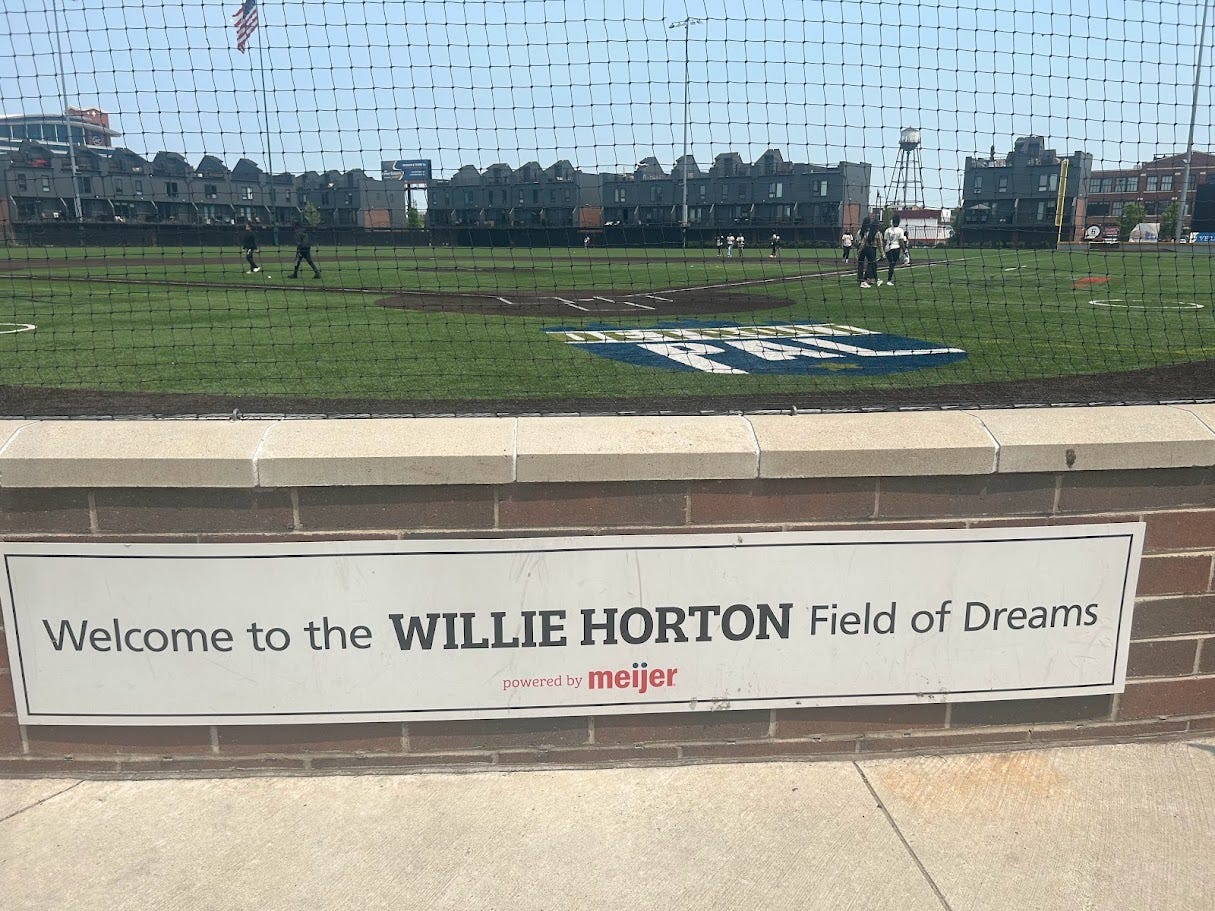
When the softball team left the field, we seized the serendipitous moment and walked out there ourselves. We stood in the batters box where Ty Cobb had stood. We strolled the base paths that had been run by Hank Greenberg and Al Kaline, and so many other Tigers. It was an experience of religious proportions.
Though the field is now used by kids and amateurs, rather than professionals, the new stadium honors its history. Above, in right field, is Kaline’s Corner. Along the walkway behind home plate are a couple placards:
Along the third base line, are several display cases that highlight Tigers history and Detroit’s baseball history:
We had trouble figuring out how to leave the field when we had finished our strolling and perusing the display cases. We found someone who led us out and only mildly chastised us for being in there when we weren’t supposed to be. The door we had used on the way in was closed on the way out.
****
We swung by the current Tiger Stadium on the way to the airport. We didn’t get to wander around the field, but we did walk around the outside and near the main entrance, is a nod to the past:
Detroit is not the city it was when it got attention in the national media for its decay. It’s renewed and vibrant. The area around the current Tigers’ stadium is incredible. The Lions and Red Wings play in the same area. It’s clean and fresh and full of people. Eminem has a restaurant across the street.
It has the same problems that urban renewal brings everywhere: high prices, gentrification, pushing out the people who were already there. In so many spots, the history and everything that came before is simply gone.
*****
Did they have to replace Old Tiger Stadium? I don’t know enough about it to offer an opinion, but the debate continues to rage online.
Even though the old stadium is gone, its history is still there. It’s in the field on the same footprint. It’s in the display cases. It’s in baseball archives.
For all the ways baseball continually reminds us that it’s a business, it belongs to us as fans in ways it can never really belong to its corporate owners. The Navin Field Grounds Crew preserved that field with their own sweat, after decades of advocacy and work by different fan groups to try and preserve the stadium. They jumped in there and saved it.
For the century that the Detroit Tigers spent at the corner of Michigan and Trumbull, they weren’t merely entertainment or a business. Going to games at Tiger Stadium was part of people’s lives in a meaningful way. It gave them joy and ways to connect with each other. The history of that place still lives there, but the history is truly in the people.
Now kids play on the spot where the Tigers used to play. The past, the future. The city of Detroit has changed and changed again since the first stadium opened. We can’t preserve everything that’s old, as painful as it can be to let go.
Tearing down Tiger Stadium may have ripped out the city’s heart. The Corner Ballpark lets it hold on to a little piece.
I’ve got another family wedding this October southeast of Boston. If anyone has any off-the-beaten path baseball tourism suggestions, I’m all ears! I’m already planning to do a tour of Fenway Park just to go there, but I’d love other baseball-y things to check out too.

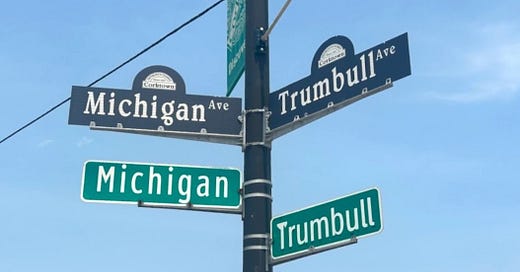


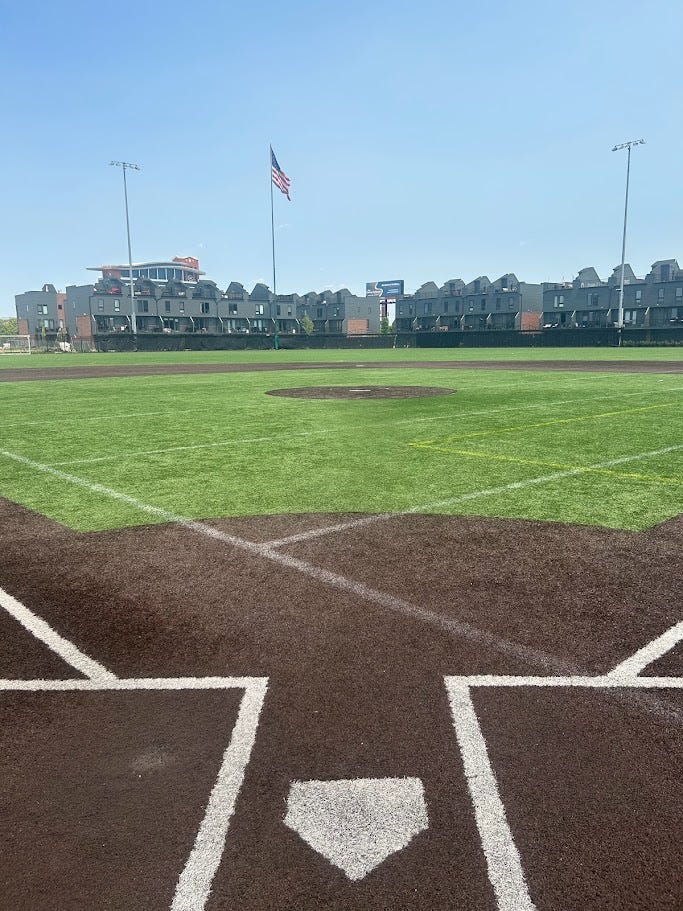
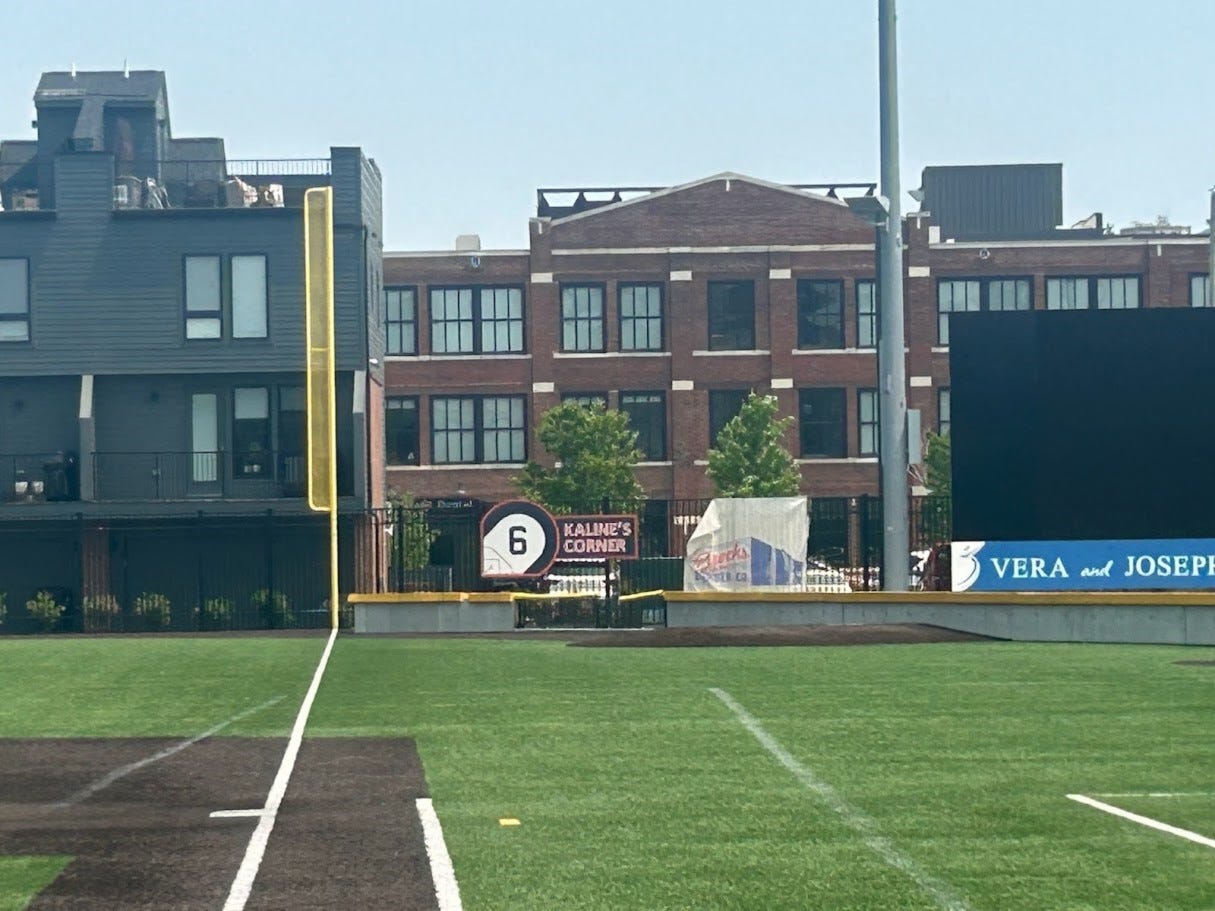
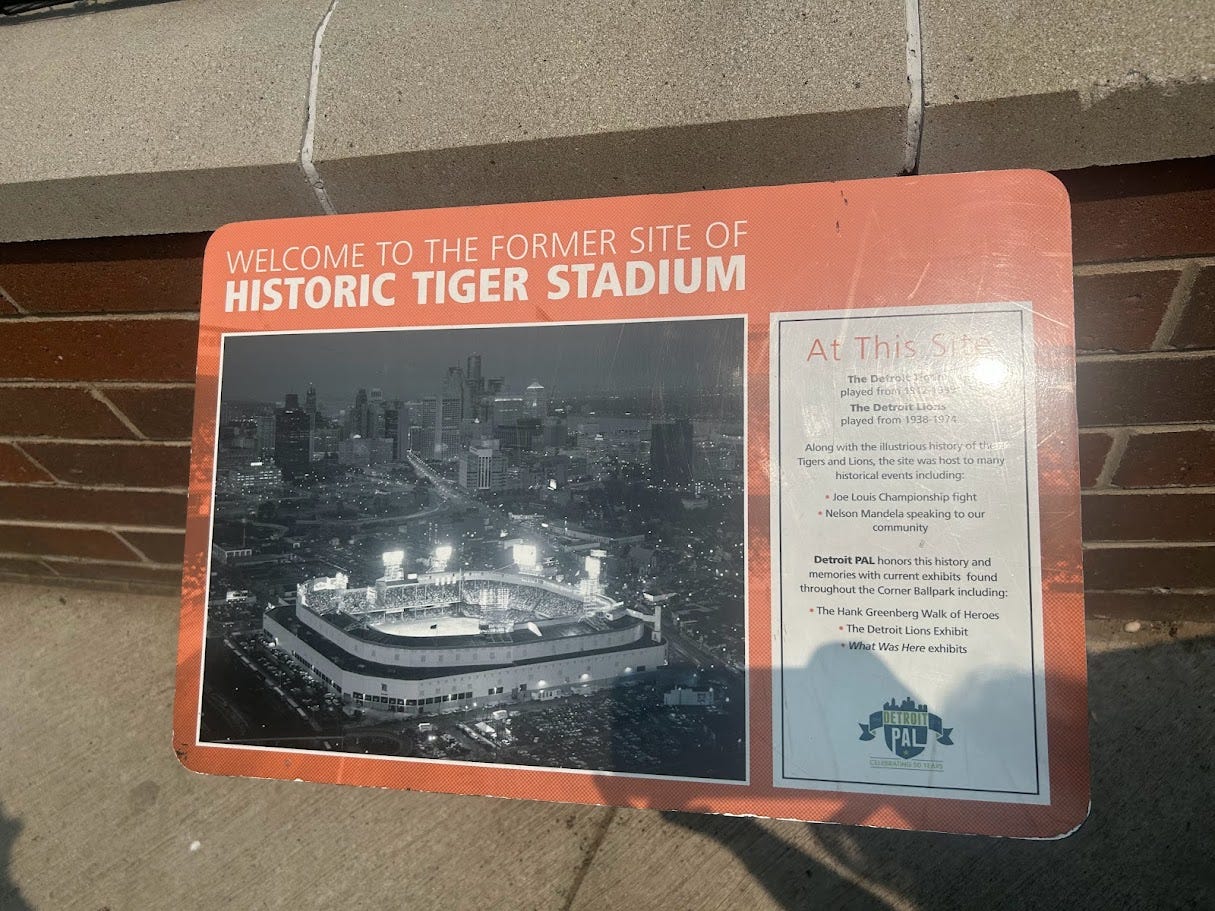
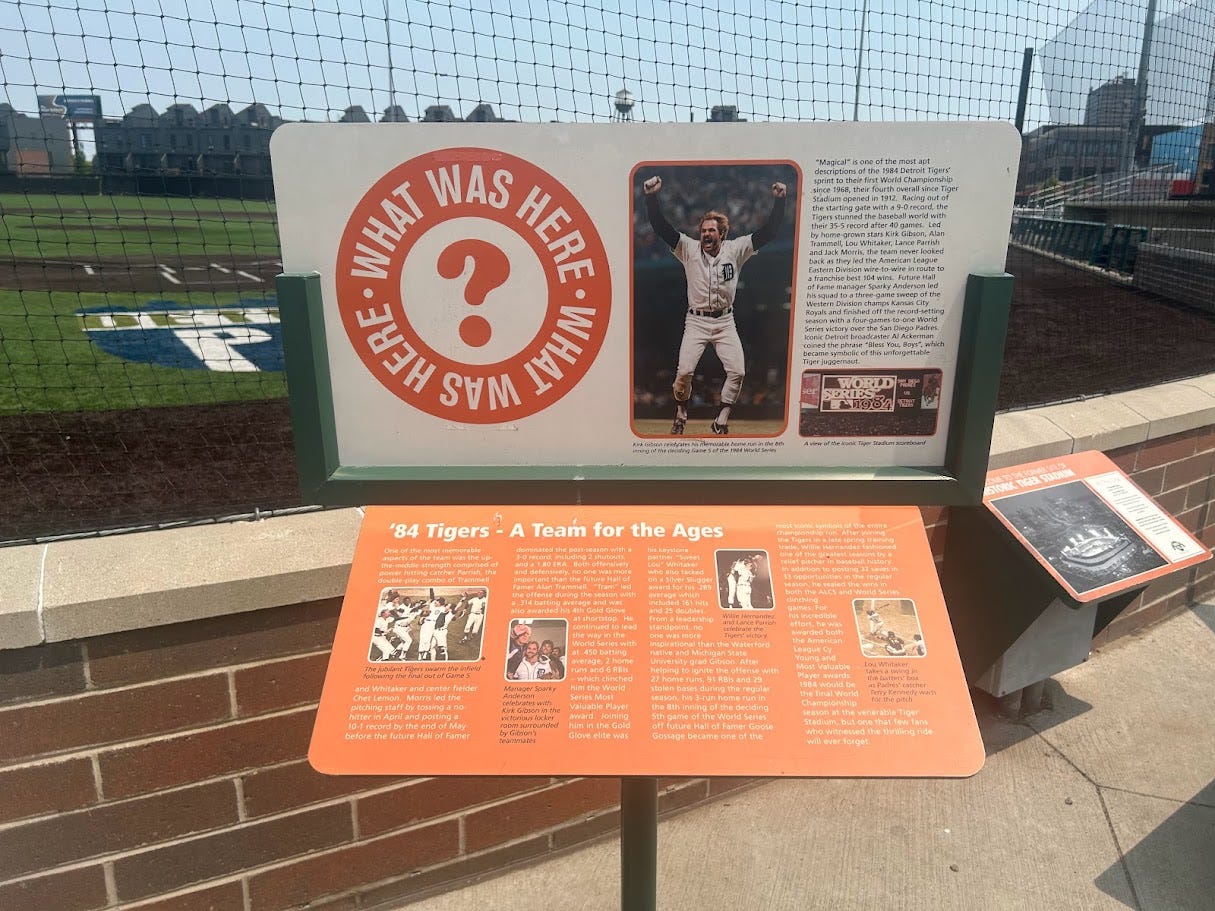
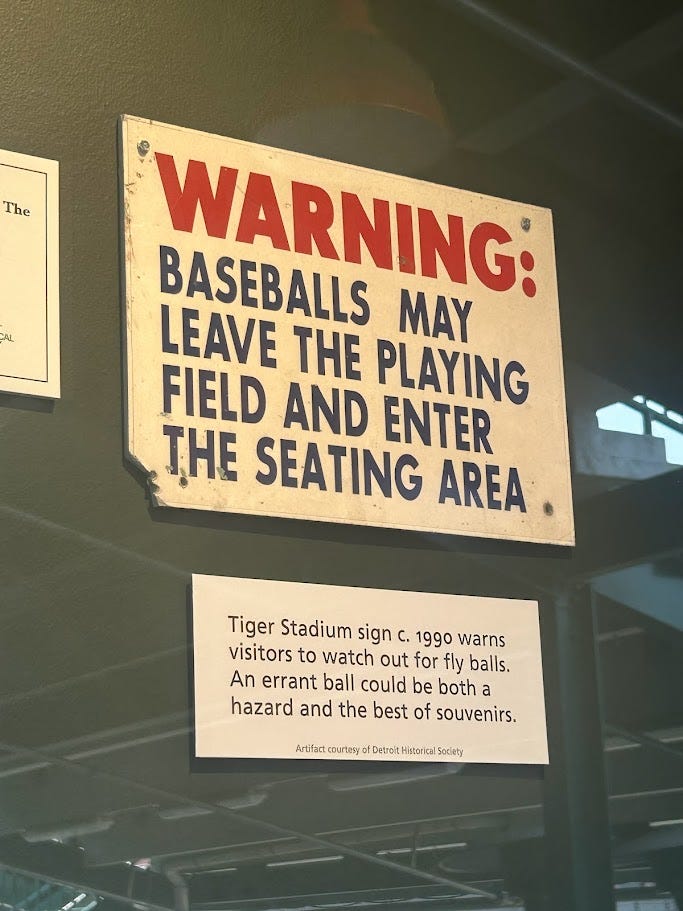
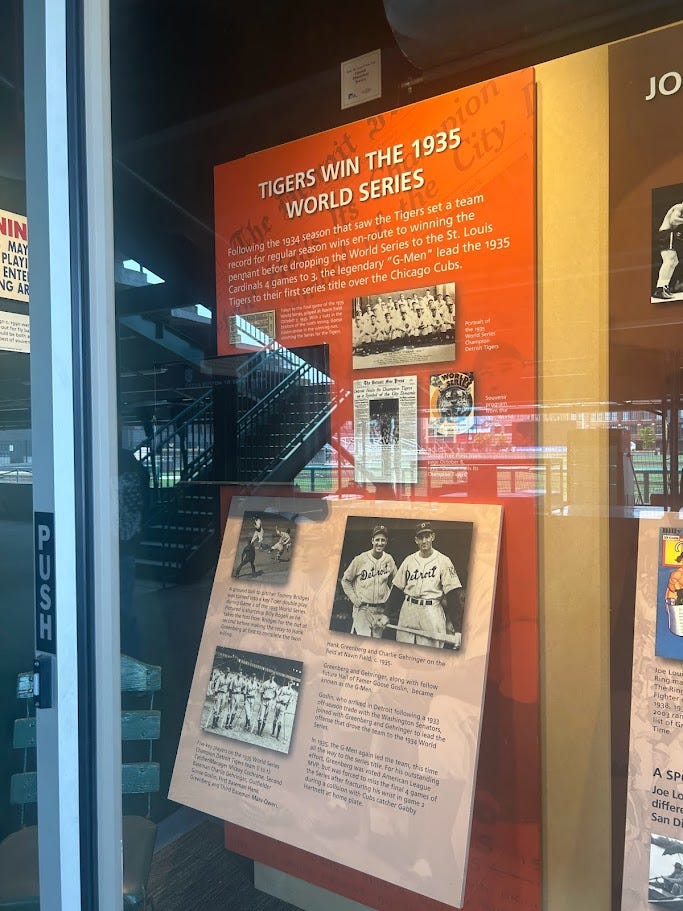
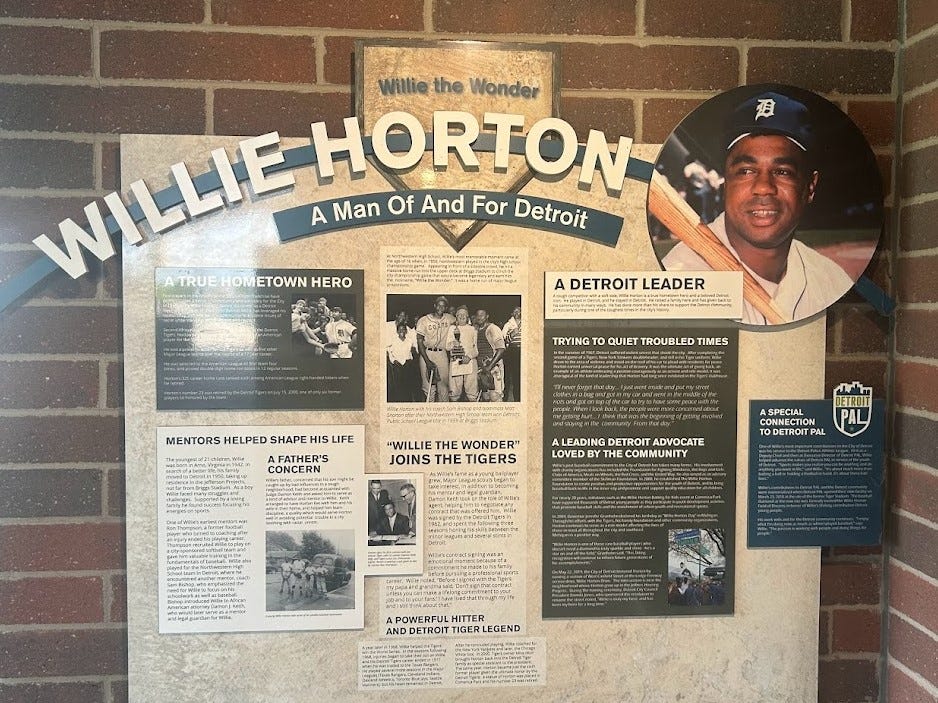
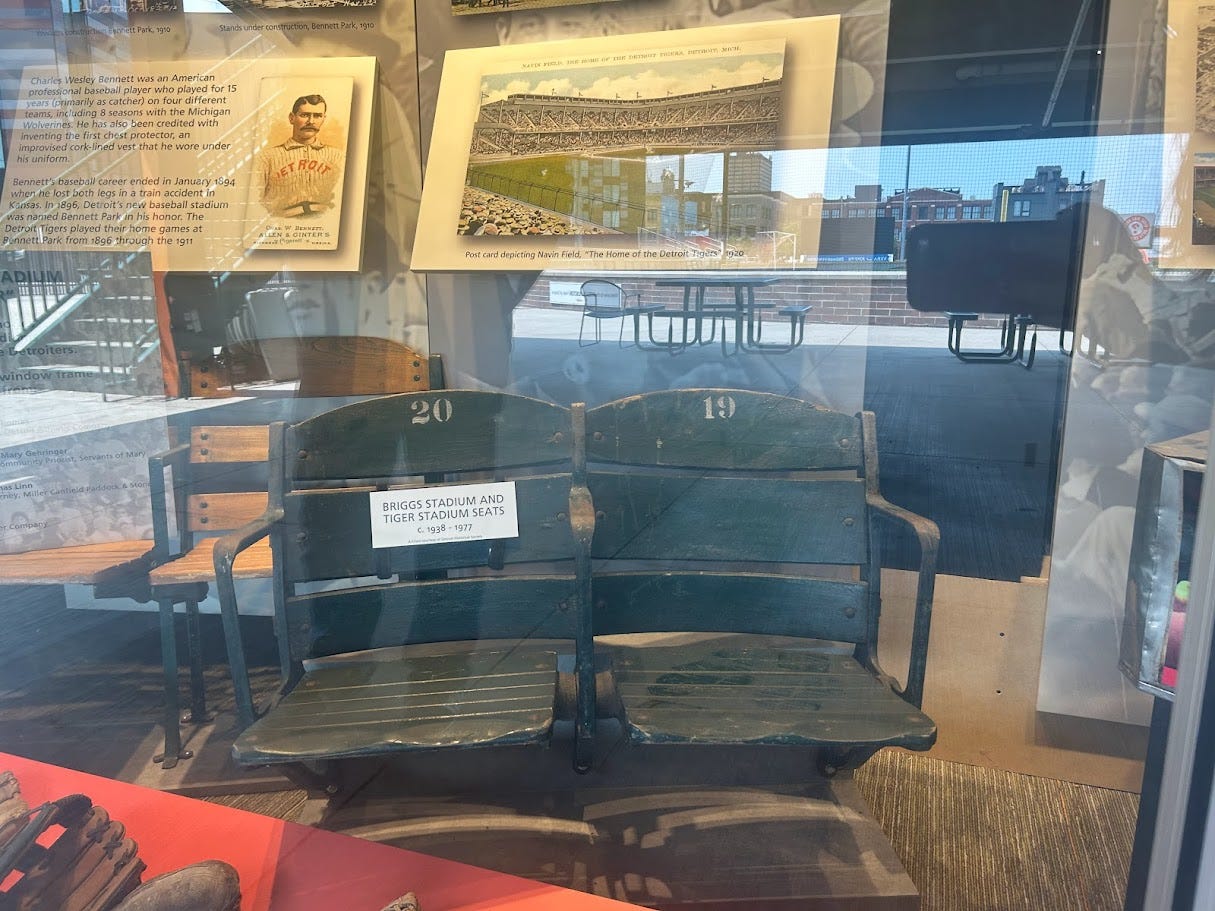
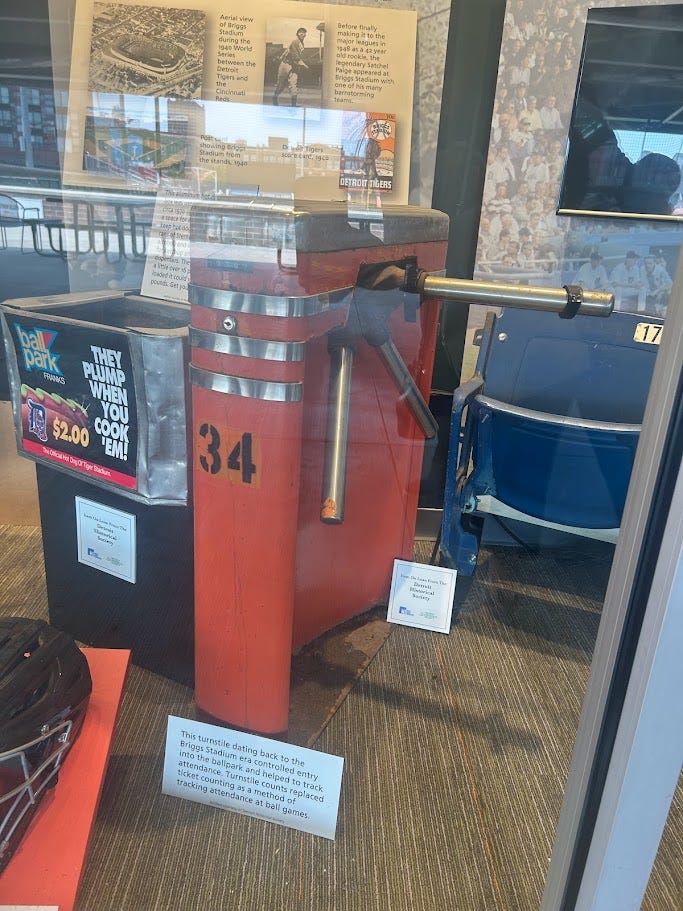
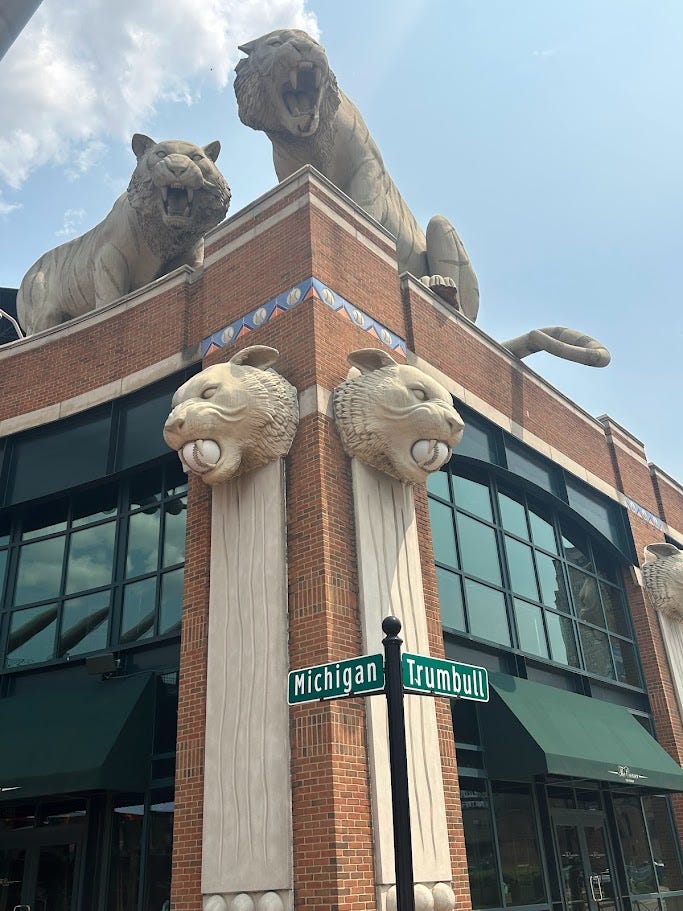
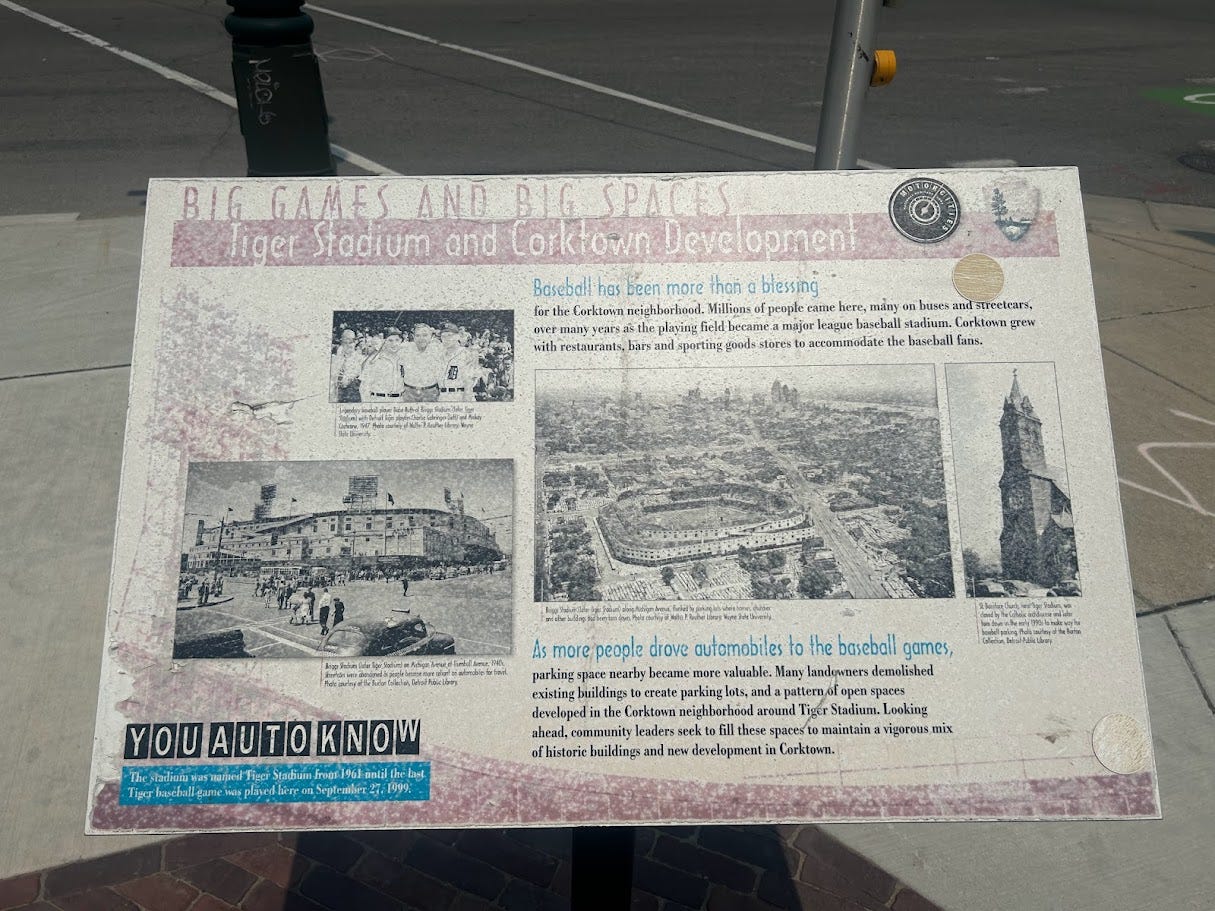
Well done Amanda! I was fortunate enough as a kid to get on the field at Tiger Stadium when visiting Detroit. My Dad knew someone who knew someone and we went on the field as the Tigers were out of town on a road trip. The tiered stands were amazing to see in person and it felt as if those tiers were right on top of the field. Then there was a flag wayyyy out in center field on a light tower where Reggie Jackson had hit a monstrous home run in the 1971 All-Star game. As a kid I marveled at how a human being could hit a baseball so far! BTW Fenway is every bit as awesome if not more so. Enjoy!
Amanda: Enjoyed your Tiger Stadium "tour" very much, well done. I saw the last three games there, by CHOICE, not by chance. I think we paid 125 dollars for centerfield bleacher tix for the last game in which Robert Fick hit the last HR (slam), the final hit. I live one mile from Fenway Park but also one mile from the Huntington Avenue Grounds (mentioned in another email) and the South End Grounds across the railroad tracks from Huntington (Northeastern University). You should read my piece on the SEG to get a feeling of what else is at Northeastern in your search for "off base" baseball. Google "NU News 50 : Home" for the 50th anniversary issue of the Northeastern News published by my many old pals from 50 years ago back in 2021. My story is about the Grounds and how Northeastern tries to ignore its significance to the area. The two ball yards were about 1,000 feet apart for a decade. There's also the Congress Street Grounds, closer to downtown, but it is also unmarked and forgotten.
Have a great time when you visit. October can be fabulous here, cool with color.
Richard Dixie Tourangeau, SABR 1980-current.
Boston, Rhode Island and Northern New England Chapters.
Questions: My email is furballdx@gmail.com